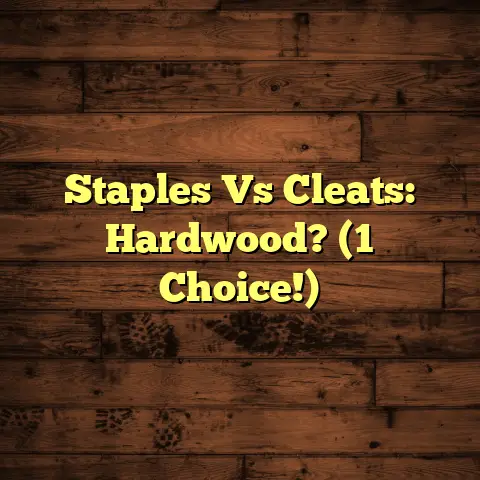Roofing Paper Under Hardwood? (2 Reasons Why!)
Ever walked into a room with stunning hardwood floors and wondered what secrets lie beneath that beautiful surface?
It’s not just about the wood itself, but also what’s underneath that contributes to its longevity and comfort.
As a flooring contractor with years of experience, I’ve seen firsthand the difference the right underlayment can make.
Today, we’re diving deep into a topic that might surprise you: roofing paper under hardwood floors.
Yes, you read that right!
Roofing paper,
the stuff you usually see on roofs, can be
a game-changer for your hardwood floors.
So, grab a cup of coffee, and let’s uncover the top two reasons why this often-overlooked material is a must-consider for your next flooring project.
Understanding Roofing Paper: A Brief Overview
Okay, let’s start with the basics. What exactly is roofing paper?
Roofing paper, at its core, is a water-resistant or waterproof material used as an underlayment beneath roofing shingles or other roof coverings.
It’s primarily designed to protect the roofing structure from moisture infiltration.
Think of it as a safety net for your roof, catching any water that might sneak through the shingles.
Now, what’s it made of?
Typically, roofing
paper consists of a base material, such as
felt or synthetic fibers, saturated with
asphalt or other waterproofing agents.
You’ll often hear about two main types:
Felt Paper: This is the traditional
stuff, made from cellulose fibers (like
recycled paper) or fiberglass, saturated
with asphalt.
It comes in different
weights, like 15-lb and 30-lb, which
indicate its thickness and water
resistance.Synthetic Roofing Underlayment: These
are newer, more advanced options made from
polypropylene or polyethylene.
They’re
lighter, stronger, and more tear-resistant
than felt paper.
So, why are we talking about roofing paper
in the context of flooring?
Well, its
moisture-resistant properties make it an
excellent candidate for protecting hardwood
floors from below.
While its primary use is on roofs, its characteristics make it useful in other applications where moisture control is needed.
Reason #1: Moisture Barrier Benefits
Alright, let’s get to the heart of the
matter.
Why should you even consider roofing
paper under your hardwood floors?
The number
one reason is moisture control.
I can’t stress enough how crucial it is to
manage moisture in flooring systems.
Hardwood
and moisture are not friends.
Excessive moisture can lead to a whole host of problems, including:
Warping and Cupping: Wood expands when
it absorbs moisture and contracts when it
dries out.
This can cause the boards to
warp, cup (edges rising), or even buckle.-
Mold and Mildew Growth: Damp environments
are breeding grounds for mold and mildew,
which can damage your floors and pose
health risks. -
Structural Damage: Moisture can seep into
the subfloor, leading to rot and structural
instability.
So, how does roofing paper help?
It acts as
a moisture barrier, preventing water vapor
from rising from the subfloor and affecting
the hardwood.
Think of it as a shield, deflecting moisture and keeping your floors dry and stable.
According to the National Wood Flooring Association (NWFA), proper moisture control is essential for the long-term performance of hardwood floors.
They recommend maintaining a consistent
relative humidity level (between 30% and 50%)
to prevent moisture-related issues.
(Source: NWFA Technical
Manual)
I’ve seen countless cases where homeowners skipped the moisture barrier, only to regret it later.
One particular instance sticks out in my
mind.
A client in a coastal town decided to
forego the roofing paper underlayment to save
a few bucks.
Within a year, their beautiful oak floors started to cup and warp due to the high humidity levels and moisture seeping up from the crawl space.
The cost of replacing the damaged floors far exceeded the initial savings.
Roofing paper provides a simple, effective
solution to this problem.
It’s a small
investment that can save you a lot of headaches
(and money) down the road.
Reason #2: Enhanced Comfort and Insulation
Okay, so we’ve established that roofing paper
is a moisture-fighting superhero.
But that’s
not all it brings to the table.
It also
enhances comfort and insulation!
You might be thinking, “Insulation? From roofing paper?” Yep, you heard that right.
While it’s not as effective as dedicated insulation materials, roofing paper does contribute to thermal insulation and soundproofing.
Let’s break it down:
Thermal Insulation: Roofing paper can help
retain heat in the winter and keep your
floors cooler in the summer.
It adds a
layer of protection against temperature
fluctuations from the subfloor.Soundproofing: Roofing paper can dampen
sound vibrations, reducing noise transmission
between floors.
This is especially beneficial
in multi-story homes or apartments.
The science behind this is pretty
straightforward.
The density and composition
of roofing paper help to absorb and dissipate
energy, whether it’s heat or sound waves.
A comfortable living environment is about
more than just aesthetics.
It’s about
creating a space where you feel relaxed and at
ease.
Enhanced insulation can lead to lower energy bills, as your HVAC system doesn’t have to work as hard to maintain a consistent temperature.
And reduced noise levels can improve your overall quality of life, especially if you live in a noisy neighborhood or have kids who love to run around.
I remember one client who installed roofing paper under their hardwood floors in their upstairs bedrooms.
They were amazed at how much warmer the rooms felt in the winter and how much quieter they were, especially during rainstorms.
They told me it made a noticeable difference in their home’s comfort level.
While roofing paper might not be the first thing that comes to mind when you think about insulation, it’s a valuable bonus that adds to the overall benefits of using it as an underlayment.
Installation Insights
Alright, so you’re convinced that roofing
paper is a good idea.
Now, how do you
actually install it?
Don’t worry; I’ve got
you covered.
Here’s a detailed overview of the installation process:
Prepare the Subfloor: This is crucial.
Make sure the subfloor is clean, dry, and
level.
Remove any debris, nails, or staples.
If there are any cracks or imperfections,
repair them with a patching compound.Unroll the Roofing Paper: Start at one
end of the room and unroll the roofing
paper, overlapping each seam by at least 2-4
inches.
This overlap is essential for
creating a continuous moisture barrier.Secure the Roofing Paper: Use a staple
gun or roofing nails to secure the roofing
paper to the subfloor.
Space the staples or
nails every 6-12 inches along the seams and
around the perimeter of the room.Seal the Seams: For added protection,
consider sealing the seams with roofing tape
or seam sealant.
This will create a
watertight barrier and prevent moisture from
seeping through the overlaps.-
Install the Hardwood Flooring: Once the
roofing paper is securely in place, you can
proceed with installing your hardwood
flooring according to the manufacturer’s
instructions.
Now, let’s talk about some common mistakes to avoid:
-
Skipping Subfloor Preparation: A dirty or
uneven subfloor can compromise the
effectiveness of the roofing paper and lead
to uneven flooring. -
Insufficient Overlap: Not overlapping the
seams properly can create gaps in the
moisture barrier. -
Using the Wrong Fasteners: Using the wrong
type of staples or nails can damage the
roofing paper or the subfloor. -
Ignoring Moisture Levels: Always check the
moisture content of both the subfloor and
the hardwood flooring before installation.They should be within the recommended range
to prevent moisture-related problems.
A few extra tips from my experience:
-
Work in Small Sections: It’s easier to
manage the roofing paper if you work in
small sections, especially in large rooms. -
Use a Utility Knife: A sharp utility
knife is essential for cutting the roofing
paper to size and trimming around obstacles. -
Wear Gloves: Roofing paper can be messy, so
wear gloves to protect your hands.
By following these installation tips and avoiding common mistakes, you can ensure that your roofing paper underlayment provides maximum protection and enhances the longevity of your hardwood floors.
Comparative Analysis
Okay, let’s address the elephant in the room.
There are other underlayment options out there.
So, how does roofing paper stack up against
the competition?
Let’s compare it to some common alternatives:
Foam Underlayment: Foam is a popular
choice for its cushioning and soundproofing
properties.
However, it’s not as effective
as roofing paper at blocking moisture.Cork Underlayment: Cork is a natural,
sustainable option that provides good
insulation and soundproofing.
But it can be
more expensive than roofing paper.Felt Underlayment (Specifically for
Flooring): Similar to roofing felt, but
often treated with additional chemicals for
moisture resistance and antimicrobial
properties.
Generally a good option, but can
be more expensive than roofing felt.
So, what are the advantages of roofing paper?
-
Cost-Effectiveness: Roofing paper is
generally one of the most affordable
underlayment options. -
Moisture Resistance: As we’ve discussed,
it’s excellent at blocking moisture. -
Durability: Roofing paper is tough and
tear-resistant, providing long-lasting
protection.
However, it’s important to acknowledge the drawbacks:
-
Limited Cushioning: Roofing paper doesn’t
provide as much cushioning as foam or cork. -
Potential Odor: Some roofing paper can
have a slight asphalt odor, especially when
first installed.
Now, let’s talk about cost.
A roll of 15-lb
felt roofing paper typically costs around
\$20-\$30, while a roll of synthetic
underlayment can range from \$50-\$100.
In comparison, foam underlayment can cost \$0.50-\$1.50 per square foot, and cork underlayment can cost \$1-\$3 per square foot.
Over the long term, using roofing paper can save you money by preventing moisture damage and extending the life of your hardwood floors.
It’s a smart investment that pays off in the form of reduced repair costs and increased home value.
Conclusion
Alright, we’ve covered a lot of ground today. Let’s recap the key takeaways:
-
Roofing paper is a valuable underlayment
option for hardwood floors due to its
moisture-resistant and insulation
properties. -
It acts as a barrier against moisture
infiltration, preventing warping, mold
growth, and structural damage. -
It contributes to thermal insulation and
soundproofing, enhancing comfort and reducing
energy costs. -
While there are other underlayment options
available, roofing paper offers a
cost-effective and durable solution for
protecting your hardwood floors.
Choosing the right materials for your home improvement projects is crucial for ensuring long-term performance and satisfaction.
Don’t underestimate the importance of what
lies beneath your floors.
It’s the foundation
for a beautiful and comfortable living space.
Call to Action
So, the next time you’re planning a hardwood flooring project, consider the benefits of incorporating roofing paper into your design.
Talk to your flooring contractor about the pros and cons of different underlayment options and choose the one that best meets your needs and budget.
Remember, a little bit of planning and preparation can go a long way in protecting your investment and creating a home that you can enjoy for years to come.
Happy flooring!
I hope this article has been
helpful and informative.
If you have any
questions, feel free to leave a comment below.





